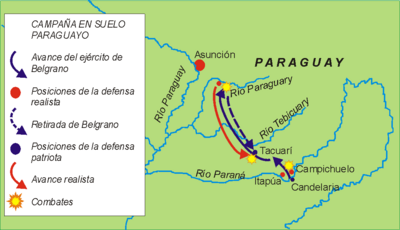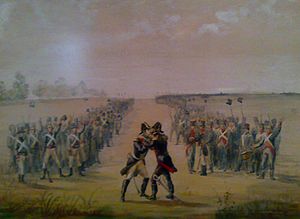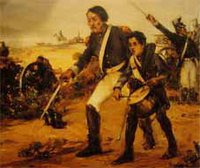Battle of Tacuarí facts for kids
Quick facts for kids Battle of Tacuarí |
|||||||
|---|---|---|---|---|---|---|---|
| Part of Paraguay campaign | |||||||
 |
|||||||
|
|||||||
| Belligerents | |||||||
| Commanders and leaders | |||||||
| Strength | |||||||
| 550 infantry and 400 cavalry | 2,500–2,700 local soldiers from Paraguay | ||||||
The Battle of Tacuarí happened on March 9, 1811. It was a fight in Southern Paraguay. Revolutionary forces from what is now Argentina fought against troops loyal to Spain. General Manuel Belgrano led the Argentine forces. Colonel Manuel Atanasio Cabañas led the Spanish loyalist troops from Paraguay.
What Led to the Battle
After the May Revolution in Buenos Aires, a new government was formed. This government, called the Primera Junta, wanted other cities to join their revolution. Buenos Aires was the capital of the Viceroyalty of the Río de la Plata. This was a large Spanish area in South America.
The governor of Paraguay, Bernardo de Velasco, refused to join the new government. He had support from the local council, called the Cabildo. Because of this, the Junta sent an army to Paraguay. They wanted to make Paraguay join the revolution.
General Manuel Belgrano was put in charge of this army. He had only 700 men. Half of them had no military experience. Belgrano's small army first fought near Asunción, Paraguay's capital. This was the Battle of Paraguarí. Belgrano was defeated there.
Belgrano had to retreat. He marched to the Tebicuary River. There, 400 men from the Guaraní joined him. These were local fighters from Yapeyú. Some men from another cavalry group also joined. The Paraguayans did not chase him. Belgrano continued his retreat to Santa Rosa.
He then learned that the situation was getting worse elsewhere. The Junta ordered him to finish the Paraguay campaign quickly. They needed his help in another area. Belgrano asked for more soldiers. He decided to stop retreating at the Tacuarí river. He wanted to set up a strong defensive position there. He hoped to hold the position until reinforcements arrived.
However, the help sent by the Junta never reached him. A small group of ships was defeated on March 2, 1811. This happened at San Nicolás de los Arroyos. So, Belgrano was left without any extra soldiers.
The Paraguayan forces advanced after Belgrano. They expected him to retreat again. The first group was led by Fulgencio Yegros. The main army was led by General Manuel Cabañas. They had about 3,000 men. They also had three cannons.
The Battle
The Paraguayan army under Cabañas had about 1,400 men. They also had 10 cannons. Cabañas led 1,000 men directly. Other groups were led by commanders like Blas José de Rojas and Fulgencio Yegros.
On March 7, the Paraguayan troops gathered. They were on the right side of the Tacuarí river. Cabañas planned to attack Belgrano. He wanted to attack from different directions.
On March 8, a bridge was finished over the river. The Paraguayan troops began to cross. On March 9, the Paraguayans attacked Belgrano's position from the front. Belgrano's forces were strong behind the Tacuarí river. This made it hard for Cabañas's men to cross under fire.
But Cabañas had a clever plan. He sent only some of his forces to cross the river directly. These included all the cannons. With the rest of his army, he went through a path in the jungle. This path was made just for this attack. Cabañas attacked Belgrano's army from the side.
Colonel José Machain, one of Belgrano's officers, tried to fight them off. But he was surrounded by Paraguayan cavalry. He was forced to surrender. Belgrano left only a few men to defend the river crossing. He then marched to help Machain. Major Celestino Vidal was in charge of the river defense. He was almost blinded by cannon fire during the battle.
Belgrano refused to surrender when Cabañas asked him to. He kept fighting strongly. This stopped the Paraguayans from advancing further. Belgrano quickly retreated with the rest of his army. They went to a nearby hill.
From there, Belgrano sent a message to Cabañas. He said that his army had come to help Paraguay, not to conquer it. Since Paraguay rejected their help, he decided to leave the province. He would cross the Paraná river with his army. Cabañas understood this as a request for peace. He ordered Belgrano to leave the province completely within one day.
What Happened After
Even though Belgrano's army lost the battle, he achieved some important things. First, he managed to get a large part of his army out of Paraguay. About 400 men, including those captured with Machain, were saved. These soldiers later became part of the army that fought in what is now Uruguay. They supported local fighters led by José Artigas.
Belgrano also wrote a proposal for a peace treaty. General Cabañas took this proposal to Asunción. It suggested free trade between Buenos Aires and Asunción. It also proposed forming a new local government in Asunción. Belgrano asked this new government to send a representative to Buenos Aires. This person would join the Junta. They would also discuss payments for the war. Belgrano's condition was that Paraguay would form its own government, free from Spain. It also had to recognize the revolutionary government in Buenos Aires.
Belgrano's biggest success was making Paraguay think seriously about becoming independent from Spain. This happened even if they didn't join the United Provinces. Soon after, on May 14, Paraguay declared its independence from Spain. This happened on May 17. They formed their first government after a peaceful uprising in Asunción. Many of the winners at Tacuarí, like Fulgencio Yegros, supported this.
Belgrano's campaign did not make Paraguay join the United Provinces. This was the original goal.
Because of his military defeat in Paraguay, Belgrano faced a military trial. This happened in Buenos Aires on June 6, 1811. But no one could find any specific charges against him. His officers from the Paraguay campaign defended him. They praised his patriotism and good conduct.
Finally, on August 9, 1811, the government cleared him of all charges. They published their decision in the Buenos Ayres Gazette. It said that General Manuel Belgrano had acted bravely. It also said he deserved recognition from his country.
The Drummer Boy of Tacuarí
There is a famous Argentine story about a child. He is called the "Drummer of Tacuarí." The story says he was involved in the battle. It is said he was a 12-year-old boy. He was a military drummer at the front lines. He guided Major Celestino Vidal, who was almost blind. The story says his name was Pedrito Ríos. He was born in Concepción del Uruguay. It is also said he died in the battle.
However, this child is not mentioned in any battle reports from that time. The first mention of the Drummer of Tacuarí came 45 years after the battle. A portrait was made soon after. It showed a 50-year-old blind man. But Vidal was only about 21 when the battle happened. This story has many parts that are unlikely. For example, an army led by a blind man. Or a 12-year-old child allowed on the front lines. Or a child being both a guide and a drummer in a battle.
Despite this, the story has become a legend in Argentine military history. Today, a military band called the "Tacuari Drummer" Regimental Band honors this story. They have a young snare drummer in their ranks. This is the only Argentine Military band to have a child musician. It pays tribute to the young drummer from Concepcion del Uruguay. He supposedly used his talent, even dying, to help the Argentine forces. This battle indirectly led to Paraguay's independence days later. Many of the winning royalist officers and soldiers supported it.
See also
 In Spanish: Batalla de Tacuarí para niños
In Spanish: Batalla de Tacuarí para niños




